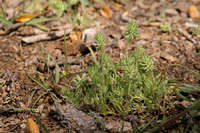|
|
 Leaves Patrick Alexander @http://swbiodiversity.org, Usage Rights: Creative Commons Attribution-ShareAlike (CC BY-SA) |  Plant Patrick Alexander @http://swbiodiversity.org, Usage Rights: Creative Commons Attribution-ShareAlike (CC BY-SA) | | | | |
|
Origin:
Introduced
Life Cycle:
Annual
General Desc:
A winter annual that emerges, flowers, and sets fruits in the spring. Plants often form dense mats that carpet large areas.
Identification notes: Annual with 3-parted basal leaves; yellow petals.
Height:
2 to 4 inches
Habitat Description: Semi-deserts, foothills, meadows, woodlands, shrublands and disturbed areas, especially grasslands. This plant seems to be expanding its range rapidly in arid and semiarid areas.
Plant Communities:
Desert Scrub, Interior Chaparral, Semidesert Grasslands, Pinyon Juniper Woodland, Montane Conifer Forest, Disturbed Areas
Elevation: 1500 - 8000 feet
Color:
Yellow
Shape:
Regular not in clusters
Tubular:
N
Flowering Period:
Apr - May
Description:
Flowers may have as few as 2 petals, instead of the usual 5 petals of this family. Flowers have 5 pale green sepals, 5 or more yellow stamens, and a dense head of greenish-yellow pistils. The flower petals are small, measuring less than 1/4 inch long.
Leaf Color:
Pale green
Leaf Type:
Simple
Leaf Shape:
Narrow
Leaf Margin:
Dissected
Leaf Attachment:
Basal
Leaves Clasp:
N
Hairs:
Leaves
Spines:
N
Leaf Description:
Short stems are sparsely covered with fine hairs. Basal leaf blades are divided into finger-like segments, resembling a bird’s foot. Each plant produces several erect stems up to 3-1/4 inches long.
Fruit Color: Pale green to light brown
Fruit Type: Achene
Fruit Notes: Soft, green heads of fruit turn brown and gray and produce a cluster of hard, spiny fruits.
Seed Notes: Achenes are up to 1/2 inch long and have 2 bulges on the base with a sharp beak on the end. Achenes are readily spread by humans and wildlife. The plant has become invasive in many areas.
|
|